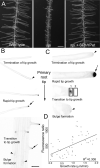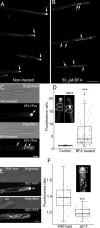Spatial and temporal localization of SPIRRIG and WAVE/SCAR reveal roles for these proteins in actin-mediated root hair development
- PMID: 33881536
- PMCID: PMC8364238
- DOI: 10.1093/plcell/koab115
Spatial and temporal localization of SPIRRIG and WAVE/SCAR reveal roles for these proteins in actin-mediated root hair development
Abstract
Root hairs are single-cell protrusions that enable roots to optimize nutrient and water acquisition. These structures attain their tubular shapes by confining growth to the cell apex, a process called tip growth. The actin cytoskeleton and endomembrane systems are essential for tip growth; however, little is known about how these cellular components coordinate their activities during this process. Here, we show that SPIRRIG (SPI), a beige and Chediak Higashi domain-containing protein involved in membrane trafficking, and BRK1 and SCAR2, subunits of the WAVE/SCAR (W/SC) actin nucleating promoting complex, display polarized localizations in Arabidopsis thaliana root hairs during distinct developmental stages. SPI accumulates at the root hair apex via post-Golgi compartments and positively regulates tip growth by maintaining tip-focused vesicle secretion and filamentous-actin integrity. BRK1 and SCAR2 on the other hand, mark the root hair initiation domain to specify the position of root hair emergence. Consistent with the localization data, tip growth was reduced in spi and the position of root hair emergence was disrupted in brk1 and scar1234. BRK1 depletion coincided with SPI accumulation as root hairs transitioned from initiation to tip growth. Taken together, our work uncovers a role for SPI in facilitating actin-dependent root hair development in Arabidopsis through pathways that might intersect with W/SC.
© The Author(s) 2021. Published by Oxford University Press on behalf of American Society of Plant Biologists.
Figures







Comment in
-
Tip growth: SPIRRIG and BRICK1 regulate root hair development by modulating the spatiotemporal dynamics of actin.Plant Cell. 2021 Aug 13;33(7):2106-2107. doi: 10.1093/plcell/koab129. Plant Cell. 2021. PMID: 35233604 Free PMC article. No abstract available.
References
-
- Alonso JM, Stepanova AN, Leisse TJ, Kim CJ, Chen H, Shinn P, Stevenson DK, Zimmerman J, Barajas P, Cheuk R, et al. (2003) Genome-wide insertional mutagenesis of Arabidopsis thaliana. Science 301: 653. - PubMed
-
- Badet T, Leger O, Barascud M, Voisin D, Sadon P, Vincent R, Le Ru A., Balague C., Roby D, Raffaele S (2019) Expression polymorphism at the ARPC4 locus links the actin cytoskeleton with quantitative disease resistance to Sclerotinia sclerotiorum in Arabidopsis thaliana. New Phytol 222: 480–496 - PubMed
Publication types
MeSH terms
Substances
LinkOut - more resources
Full Text Sources
Other Literature Sources
Molecular Biology Databases
Miscellaneous

